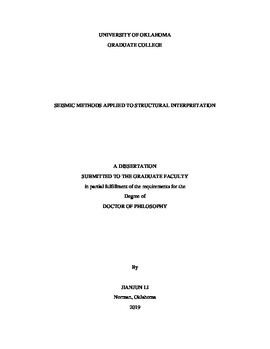| dc.contributor.advisor | Mitra, Shankar | |
| dc.contributor.author | Li, Jianjun | |
| dc.date.accessioned | 2019-12-13T14:29:20Z | |
| dc.date.available | 2019-12-13T14:29:20Z | |
| dc.date.issued | 2019-12-13 | |
| dc.identifier.uri | https://hdl.handle.net/11244/322865 | |
| dc.description.abstract | Seismic modeling and seismic attribute assisted interpretation are conducted to illustrate the use of seismic methods in structural interpretation. Pre-stack time migration (PSTM) seismic modeling is used to study common pitfalls and artifacts associated with the pre-stack time migrated seismic data in common fold-thrust structures. Fault-bend fold models are well imaged but with gentle “pull-ups” due to the lateral velocity variance. Fault -propagation folds exhibit significant footwall “pull-ups” and poor imaging of the steep front limbs. The maximum slip (S) on the fault plays an important role on the dip of the front limbs of trishear fault-propagation folds, and therefore the imaging quality of the front limbs. The fault propagation to slip ratio (P/S ratio) has a lesser influence on the signature of the fault and front limbs. Lateral thickness changes in the high velocity salt or low velocity mobile shale substrate associated with detachment and faulted-detachment folds cause “pull-ups”, “push-downs” and other artifacts. The structures seen on the seismic are also sensitive to the accuracy of the root-mean-square (RMS) velocity used for migration, whereby errors in velocity analysis cause distortion in the resulting geometry of the structures.
We also conducted seismic attribute analysis using advanced fault probability attribute on a 3D seismic survey in the Great South Basin, New Zealand. The attribute sharpens the discontinuities associated with polygonal faults which are difficult to interpret due to their complex planiform geometry. Four separate polygonal fault patterns are recognized based on the mechanism of formation and the slope of the faulted units at the time of formation. The formation of the polygonal fault systems in the Great South Basin is related to volume reduction and shear failure due to the opal-A to opal-CT transition within the sediments. | en_US |
| dc.language | en_US | en_US |
| dc.subject | Structural Geology | en_US |
| dc.subject | Seismic interpretation | en_US |
| dc.subject | Seismic modeling | en_US |
| dc.subject | Polygonal faults | en_US |
| dc.title | Seismic methods applied to structural interpretation | en_US |
| dc.contributor.committeeMember | Marfurt, Kurt | |
| dc.contributor.committeeMember | Carpenter, Brett | |
| dc.contributor.committeeMember | Behm, Michael | |
| dc.contributor.committeeMember | Wu, Xingru | |
| dc.date.manuscript | 2019-12-05 | |
| dc.thesis.degree | Ph.D. | en_US |
| ou.group | Mewbourne College of Earth and Energy::School of Geosciences | en_US |
| shareok.orcid | 0000-0003-2575-2906 | en_US |
